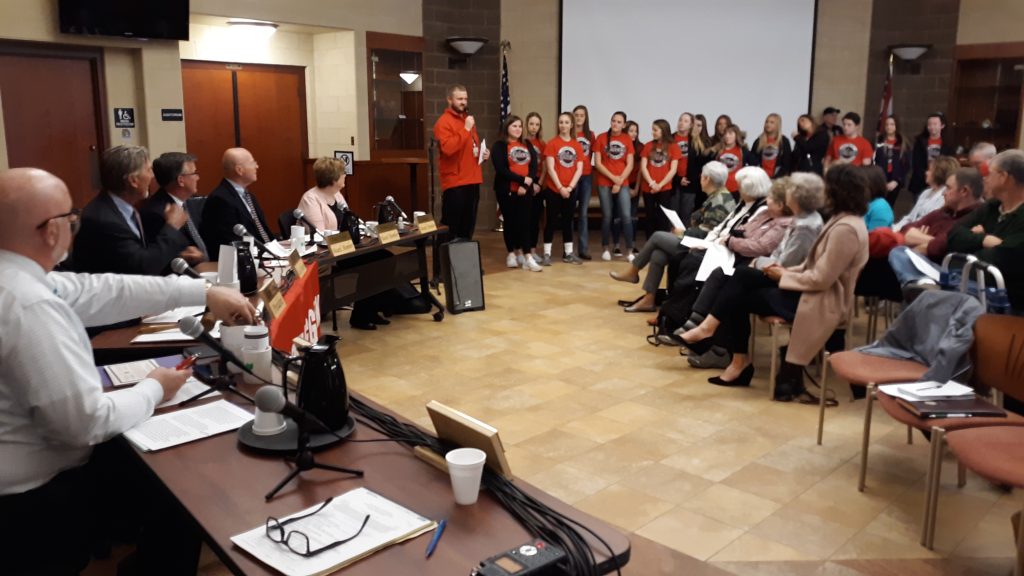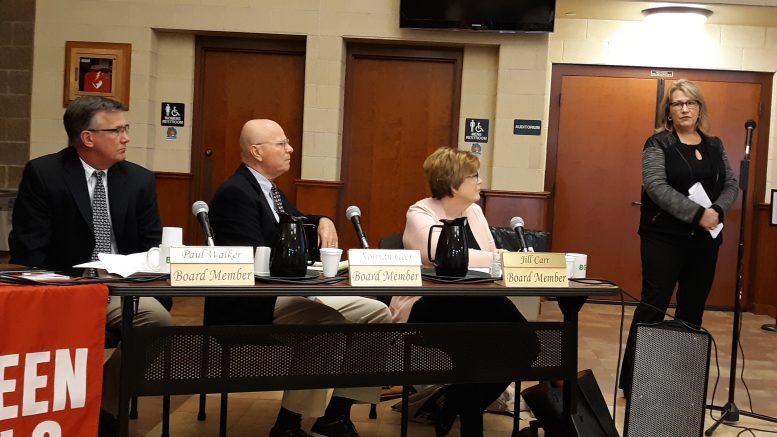By JAN LARSON McLAUGHLIN
BG Independent News
Young children with developmental and physical disabilities learn and play side-by-side with “typical” children in Bowling Green City Schools preschool program. For some of these children, this is the only time in their education where there is complete integration with other children of all abilities.
“The research shows it’s very important that preschoolers with special needs benefit from being with typical developing children,” Melanie Garbig, executive director of pupil services, explained at Tuesday’s Board of Education meeting.
The preschool program has been the target of some school critics, who have questioned why the district spends taxpayer money on the program.
Garbig answered that question – because the district is legally required to do so.
The school district has offered preschool for ages 3 to 5 since 1994. The program was first located in the old central administration building, then the Jordan Family Center, then Crim Elementary, and now at Conneaut Elementary.
Garbig was principal of Crim when the program was housed there.
“It was great to have the preschool in Crim,” she said.
There are currently four preschool classrooms in the morning and in the afternoon, with a maximum of 16 children – eight with special needs and eight typical peers.
“We have a lot of specialists who help develop the children,” Garbig said. There are speech language pathologists, occupational therapists and physical therapists.
The services “can make them grow like little flowers,” she said.
Bowling Green’s preschool program earned the Ohio Department of Education’s 5-Star rating last year.
“That means we had met all the qualifications for a preschool program,” Garbig said. “It was actually quite a feat.”
The program tracks the students’ progress with Early Learning Assessments. The district is finding that all the early intervention is paying off for many students with special needs.
“It really results in students not needing IEPs (Individualized Education Program) when they enter kindergarten,” Garbig said.
For those who question the value of such an integrated preschool, Garbig showed a video of an economist talking about the impact of early childhood education on the economy.
“Why should I pay more taxes to pay for other people’s children,” he asked. Because, to not do so would be short-sighted, he answered. When other people’s children get more education and skills, everyone benefits, he said. That is the return for having early intervention.
Not to mention, the district is required to provide services to students with disabilities starting at age 3, said Emily Mennitt, school psychologist. The Individuals with Disabilities Education Act requires the district to identify children with special needs, then provide them with an education.
“We are responsible for what is called ‘child find,’” Mennitt said. That means the district must evaluate any child with possible learning disabilities.
The district gets lots of referrals from the following sources:
- Early intervention programs like Help Me Grow, which works with children from birth to age 3.
- Parents who are concerned about their child’s development.
- Pediatricians who have concerns about a child.
- Local private preschools.
- Head Start at the Jordan Family Center.
The preschool guarantees these children will not fall through the cracks.
“Their child will not be without services,” Mennitt said.
By law, once identifying children with special needs, the district must offer a Free and Appropriate Public Education, she explained. And that means an inclusive education.
“Children are fully included,” despite physical or learning disabilities, Mennitt said. “Everybody is included and working together.”
Family engagement is also required, with educators forming long-term relationships with parents, she said.
The district receives state funding for special needs students. Other typical students are charged about $1,000 per year for the preschool services. The district doesn’t yet qualify for state grants for typical students, but hopes to if it goes to all-day services.
“It’s so important for them to be there, as a typical developing child,” Mennitt said.
This year, the preschool program has 48 special needs students and 66 others. Last year, the number was 56 special needs and 58 others. Typical children are taken on a first-come first-served basis. There was a waiting list this year for children, Garbig said.
Kisha Nichols, a Kenwood kindergarten teacher, talked about the need for the preschool program.
“Our preschool program is invaluable,” she said. “Our students are coming much more socially and emotionally ready for kindergarten.”
The program not only benefits the special needs students, but also their peers who learn tolerance for people who are different from them, she said.
“I really firmly believe that is the result of our preschool program,” Nichols said.
In other business at the meeting, board president Ginny Stewart said a special board meeting will be held March 26, at 6:30 p.m., in the Performing Arts Center, for members of the school facilities and finance task forces to present their recommendations.
Also at the meeting, Superintendent Francis Scruci talked about the timing of spring break during the first full week of March. That schedule is important due to state testing, he said.
“Until the state decides that over-testing our students isn’t necessary,” the district will stick with that schedule, Scruci said.

Also at the meeting, athletic director Dirk Conner introduced top athletes from the winter sports of basketball, wrestling, bowling and cheerleading. In addition to their success in sports, the students had an average GPA of 3.513.
“There’s a common misconception of dumb jocks,” that these kids prove wrong, Conner said.

